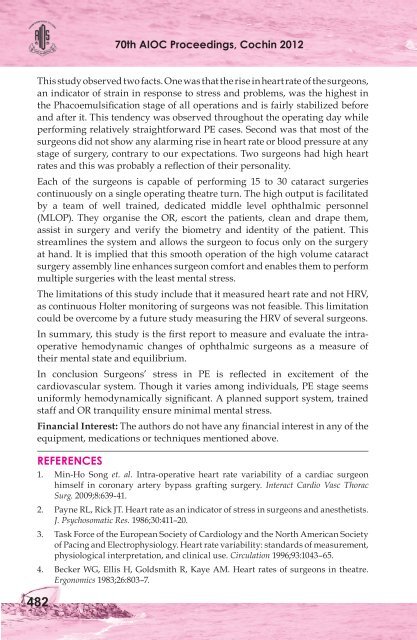Comprehensive Ophthalmology Free Papers - aioseducation
Comprehensive Ophthalmology Free Papers - aioseducation
Comprehensive Ophthalmology Free Papers - aioseducation
Create successful ePaper yourself
Turn your PDF publications into a flip-book with our unique Google optimized e-Paper software.
70th AIOC Proceedings, Cochin 2012<br />
This study observed two facts. One was that the rise in heart rate of the surgeons,<br />
an indicator of strain in response to stress and problems, was the highest in<br />
the Phacoemulsification stage of all operations and is fairly stabilized before<br />
and after it. This tendency was observed throughout the operating day while<br />
performing relatively straightforward PE cases. Second was that most of the<br />
surgeons did not show any alarming rise in heart rate or blood pressure at any<br />
stage of surgery, contrary to our expectations. Two surgeons had high heart<br />
rates and this was probably a reflection of their personality.<br />
Each of the surgeons is capable of performing 15 to 30 cataract surgeries<br />
continuously on a single operating theatre turn. The high output is facilitated<br />
by a team of well trained, dedicated middle level ophthalmic personnel<br />
(MLOP). They organise the OR, escort the patients, clean and drape them,<br />
assist in surgery and verify the biometry and identity of the patient. This<br />
streamlines the system and allows the surgeon to focus only on the surgery<br />
at hand. It is implied that this smooth operation of the high volume cataract<br />
surgery assembly line enhances surgeon comfort and enables them to perform<br />
multiple surgeries with the least mental stress.<br />
The limitations of this study include that it measured heart rate and not HRV,<br />
as continuous Holter monitoring of surgeons was not feasible. This limitation<br />
could be overcome by a future study measuring the HRV of several surgeons.<br />
In summary, this study is the first report to measure and evaluate the intraoperative<br />
hemodynamic changes of ophthalmic surgeons as a measure of<br />
their mental state and equilibrium.<br />
In conclusion Surgeons’ stress in PE is reflected in excitement of the<br />
cardiovascular system. Though it varies among individuals, PE stage seems<br />
uniformly hemodynamically significant. A planned support system, trained<br />
staff and OR tranquility ensure minimal mental stress.<br />
Financial Interest: The authors do not have any financial interest in any of the<br />
equipment, medications or techniques mentioned above.<br />
REFERENCES<br />
1. Min-Ho Song et. al. Intra-operative heart rate variability of a cardiac surgeon<br />
himself in coronary artery bypass grafting surgery. Interact Cardio Vasc Thorac<br />
Surg. 2009;8:639-41.<br />
2. Payne RL, Rick JT. Heart rate as an indicator of stress in surgeons and anesthetists.<br />
J. Psychosomatic Res. 1986;30:411–20.<br />
3. Task Force of the European Society of Cardiology and the North American Society<br />
of Pacing and Electrophysiology. Heart rate variability: standards of measurement,<br />
physiological interpretation, and clinical use. Circulation 1996;93:1043–65.<br />
4. Becker WG, Ellis H, Goldsmith R, Kaye AM. Heart rates of surgeons in theatre.<br />
Ergonomics 1983;26:803–7.<br />
482

















